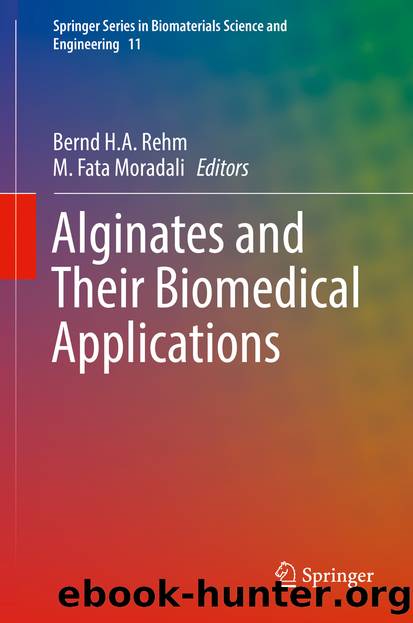Alginates and Their Biomedical Applications by Bernd H.A. Rehm & M. Fata Moradali

Author:Bernd H.A. Rehm & M. Fata Moradali
Language: eng
Format: epub
Publisher: Springer Singapore, Singapore
5.3.2.2 Cartilage Tissue Engineering
Alginate-based hydrogels are widely used as therapeutic materials for cartilage tissue regeneration [61]. However, the major challenge of using alginate hydrogels in biofabrication technique to design 3D scaffold is their inability to maintain a uniform 3D structure. To overcome this problem, alginate hydrogel was integrated with a synthetic polymer, polycaprolactone (PCL) [62]. In this study, additive manufacturing (AM) technique with a multihead deposition system (MHDS) was used to fabricate 3D scaffolds by plotting primary nasal septal cartilage chondrocytes and/or TGF-β-embedded alginate hydrogel in between the plotted PCL struts using a layer-by-layer plotting approach. Using the MHDS, multiple biomaterial inks can be dispensed to plot complex 3D scaffolds, which can closely mimic our tissue structure. In vitro cell studies showed that cell viability was reduced to about 85% when multiple PCL layers were plotted compared to the single-layer constructs, where cell viability was found to be 95–97%. Though the cell viability reduced due to plotting more PCL matrix in the constructs, the reduction was not significantly low, which suggested that the shear stress due to dispensing cell-containing alginate matrix did not have a significant impact on cell viability. In vitro biochemical assay indicated that more glycosaminoglycan (GAG) and total collagen were expressed by the cells in the constructs having TGF-β-containing alginate. Moreover, more cartilaginous tissue formation was observed for the constructs having 4% alginate gels compared to the 6% alginate gels. For in vivo study, three different types of scaffolds were printed and that were composed of PCL+ alginate gel (no cells) named as group I;, PCL+ alginate gel (chondrocytes), group II; and PCL+ alginate gel (chondrocytes + TGF-β), group III, which were implanted into the dorsal subcutaneous spaces of a 7-week-old female nude mice. After 4 weeks, accumulation of more GAG and formation of cartilaginous tissue and type II collagen were observed in the constructs of group III compared to that in the constructs of other two groups. Type II collagen exhibits a fibrillar structure of healthy cartilage tissue that maintains the mesh structure of cartilage and takes water-retentive proteoglycan into its pores. In order to recapitulate the nanofibrous matrix constitution of the native musculoskeletal soft tissue, a fibrous bio-ink composed of alginate and polylactic acid (PLA) nanofibers was used to print tissue engineering constructs [63]. Human adipose-derived stem cells (hADSCs) containing alginate-PLA nanofibers bio-ink was plotted to fabricate the construct that can mimic the structure of human medial knee meniscus, which was digitally modeled using magnetic resonance imaging. Viability study showed that the PLA nanofibers-containing alginate constructs promoted higher cell viability and proliferation compared to the constructs having alginate only. At day 7, metabolic activity of the hADSCs was found to be 28.5% higher in the nanofiber-containing constructs compared to the constructs without nanofiber. Most importantly, collagen and proteoglycans were found to be prominent in the areas surrounding the hADSCs in the nanofiber-containing constructs which confirmed the ability of bioprinted hMSC to differentiate down the chondrogenic pathway. In another study, nanofibrillated cellulose (NFC) was mixed with
Download
This site does not store any files on its server. We only index and link to content provided by other sites. Please contact the content providers to delete copyright contents if any and email us, we'll remove relevant links or contents immediately.
| Automotive | Engineering |
| Transportation |
Whiskies Galore by Ian Buxton(41879)
Introduction to Aircraft Design (Cambridge Aerospace Series) by John P. Fielding(33064)
Small Unmanned Fixed-wing Aircraft Design by Andrew J. Keane Andras Sobester James P. Scanlan & András Sóbester & James P. Scanlan(32743)
Craft Beer for the Homebrewer by Michael Agnew(18140)
Turbulence by E. J. Noyes(7936)
The Complete Stick Figure Physics Tutorials by Allen Sarah(7307)
Kaplan MCAT General Chemistry Review by Kaplan(6867)
The Thirst by Nesbo Jo(6826)
Bad Blood by John Carreyrou(6552)
Modelling of Convective Heat and Mass Transfer in Rotating Flows by Igor V. Shevchuk(6391)
Learning SQL by Alan Beaulieu(6209)
Weapons of Math Destruction by Cathy O'Neil(6143)
Man-made Catastrophes and Risk Information Concealment by Dmitry Chernov & Didier Sornette(5921)
Digital Minimalism by Cal Newport;(5664)
Life 3.0: Being Human in the Age of Artificial Intelligence by Tegmark Max(5474)
iGen by Jean M. Twenge(5366)
Secrets of Antigravity Propulsion: Tesla, UFOs, and Classified Aerospace Technology by Ph.D. Paul A. Laviolette(5309)
Design of Trajectory Optimization Approach for Space Maneuver Vehicle Skip Entry Problems by Runqi Chai & Al Savvaris & Antonios Tsourdos & Senchun Chai(5011)
Pale Blue Dot by Carl Sagan(4912)
